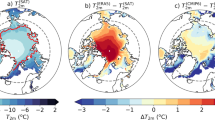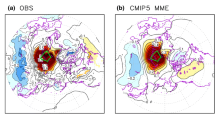Abstract
Arctic warming is one of the most striking signals of global warming. The Arctic is one of the fastest warming regions on Earth and constitutes, thus, a good test bed to evaluate the ability of climate models to reproduce the physics and dynamics involved in Arctic warming. Different physical and dynamical mechanisms have been proposed to explain Arctic amplification. These mechanisms include the surface albedo feedback and poleward sensible and latent heat transport processes. During the winter season when Arctic amplification is most pronounced, the first mechanism relies on an enhancement in upward surface heat flux, while the second mechanism does not. In these mechanisms, it has been proposed that downward infrared radiation (IR) plays a role to a varying degree. Here, we show that the current generation of CMIP5 climate models all reproduce Arctic warming and there are high pattern correlations—typically greater than 0.9—between the surface air temperature (SAT) trend and the downward IR trend. However, we find that there are two groups of CMIP5 models: one with small pattern correlations between the Arctic SAT trend and the surface vertical heat flux trend (Group 1), and the other with large correlations (Group 2) between the same two variables. The Group 1 models exhibit higher pattern correlations between Arctic SAT and 500 hPa geopotential height trends, than do the Group 2 models. These findings suggest that Arctic warming in Group 1 models is more closely related to changes in the large-scale atmospheric circulation, whereas in Group 2, the albedo feedback effect plays a more important role. Interestingly, while Group 1 models have a warm or weak bias in their Arctic SAT, Group 2 models show large cold biases. This stark difference in model bias leads us to hypothesize that for a given model, the dominant Arctic warming mechanism and trend may be dependent on the bias of the model mean state.







Similar content being viewed by others
References
Abbot DS, Tziperman E (2008a) A high-latitude convective cloud feedback and equable climates. Q J R Meteorol Soc 134:165–185
Abbot DS, Tziperman E (2008b) Sea ice, high-latitude convection, and equable climates. Geophys Res Lett 35:L03702
Baggett C, Lee S (2015) Arctic warming induced by tropically forced tapping of available potential energy and the role of the planetary-scale waves. J Atmos Sci 72:1562–1568
Barnes EA, Dunn-Sigouin E, Masato G, Woollings T (2014) Exploring recent trends in Northern Hemisphere blocking. Geophys Res Lett 41:638–644
Bekryaev RV, Polyakov IV, Alexeev VA (2010) Role of polar amplification in long-term surface air temperature variations and modern Arctic warming. J Clim 23:3888–3906
Budyko MI, Izrael YA (1991) In: Budyko MI, Izrael YA (eds) Anthropogenic climate change, pp 277–318. Uni. Ariz. Press, Tucson
Cai M (2005) Dynamical amplification of polar warming. Geophys Res Lett 32:L22710. doi:10.1029/2005GL024481
Cai M (2006) Dynamical greenhouse-plus feedback and polar warming amplification. Part I: a dry radiative-transportive climate model. Clim Dyn 26:661–675
Compo GP, Sardeshmukh PD (2009) Oceanic influences on recent continental warming. Clim Dyn 32:333–342
Ding Q, Wallace JM, Battisti DS, Steig EJ, Gallant AJE, Kim H-J, Geng L (2014) Tropical forcing of the recent rapid Arctic warming in northeastern Canada and Greenland. Nature 509:209–213
Francis JA, Vavrus SJ (2012) Evidence linking Arctic amplification to extreme weather in mid-latitudes. Geophys Res Lett 39:L06801. doi:10.1029/2012GL051000
Franzke C (2012) On the statistical significance of surface air temperatures trends in the Eurasian Arctic region. Geophys Res Lett 39:L23705. doi:10.1029/2012GL054244
Goss M, Feldstein S, Lee S (2016) Stationary wave interference and its relation to tropical convection and Arctic warming. J Clim 29:1369–1389
Graversen RG (2006) Do changes in the midlatitude circulation have any impact on the Arctic surface air temperature trend? J Clim 19:5422–5438
Hoffert MI, Covey C (1992) Deriving global climate sensitivity from palaeoclimate reconstructions. Nature 360:573–576
Hoskins BJ, Karoly DJ (1981) The steady linear response of a spherical atmosphere to thermal and orographic forcing. J Atmos Sci 38:1179–1196
Hung M-P, Lin J-L, Wang W, Kim D, Shinoda T, Weaver SJ (2013) MJO and convectively coupled equatorial waves simulated by CMIP5 climate models. J Clim 26:6185–6214
Kay JE, L’Ecuyer T, Gettelmann A, Stephens G, O’Dell C (2008) The contribution of cloud and radiation anomalies to the 2007 Arctic sea ice extent minimum. Geophys Res Lett 35:L08503. doi:10.1029/2008GL033451
Kistler R, Collins W, Saha S, White G, Woollen J, Kalnay E, Chelliah M, Ebisuzaki W, Kanamitsu M, Kousky V et al (2001) The NCEP-NCAR 50-year reanalysis: monthly means CD-ROM and documentation. Bull Am Meteorol Soc 82:247–267
Kobayashi S, Ota Y, Harada Y, Ebita A, Moriya M, Onoda H, Onogi K, Kamahori H, Kobayashi C, Endo H, Miyaoka K, Takahashi K (2015) The JRA-55 reanalysis: general specifications and basic characteristics. J Met Soc Jpn 93:5–48
Krishnamurti T, Krishnamurti R, Das S, Kumar V, Jayakumar A, Simon A (2015) A pathway connecting the monsoonal heating to the rapid arctic ice melt. J Atmos Sci 72:534
Langen PL, Alexeev VA (2007) Polar amplification as a preferred response in an idealized aquaplanet GCM. Clim Dyn 29:305–317
Lee S (2014) A theory for polar amplification from a general circulation perspective. Asia Pac J Atmos Sci 50:31
Lee S, Feldstein SB, Pollard D, White TS (2011a) Do planetary wave dynamics contribute to equable climates? J Clim 24:2391–2404
Lee S, Gong T, Johnson N, Feldstein SB, Pollard D (2011b) On the possible link between tropical convection and the Northern Hemisphere Arctic surface air temperature change between 1958 and 2001. J Clim 24:4350–4367
Lenton TM, Held H, Kriegler E, Hall JW, Lucht W, Rahmstorff S, Schellnhuber HJ (2008) Tipping elements in the earth’s climate system. Proc Natl Acad Sci USA 105:1786–1793
Liu J, Curry JA, Wang H, Song M, Horton RM (2012) Impact of declining Arctic sea ice on winter snowfall. Proc Natl Acad Sci USA 109:4074–4079
Lu J, Cai M (2009) A new framework for isolating individual feedback processes in coupled general circulation climate models. Part I: formulation. Clim Dyn 32:873–885
Manabe S, Wetherald RT (1975) The effects of doubling the CO\(_2\) concentration on the climate of a general circulation model. J Atmos Sci 32:3–15
Park D-S, Lee S, Feldstein SB (2015a) Attribution of the recent winter sea-ice decline over the Atlantic sector of the Arctic Ocean. J Clim 28:4027–4033
Park H-S, Lee S, Son S-W, Feldstein SB, Kosaka Y (2015b) The impact of poleward moisture and sensible heat flux on Arctic winter sea-ice variability. J Clim 28:5030–5040
Perlwitz J, Hoerling M, Dole R (2015) Arctic tropospheric warming: causes and linkages to lower latitudes. J Clim 28:2154–2167
Pithan F, Mauritsen T (2014) Arctic amplification dominated by temperature feedbacks in contemporary climate models. Nat Geosci 7:181–184
Sardeshmukh PD, Hoskins BJ (1988) The generation of global rotational flow by steady idealized tropical divergence. J Atmos Sci 45:1228–1251
Screen JA (2014) Arctic amplification decreases temperature variance in northern mid- to high-latitudes. Nat Clim Change 4:577–582
Screen JA, Simmonds I (2010) The central role of diminishing sea ice in recent Arctic temperature amplification. Nature 464:1334–1337
Serreze MC, Barry RG (2011) Processes and impacts of Arctic amplification: a research synthesis. Glob Planet Change 77:85–96
Shin S-I, Sardeshmukh PD (2011) Critical influence of the pattern of tropical ocean warming on remote climate trends. Clim Dyn 36:1577–1591
Stroeve JC, Kattsov V, Barrett A, Serreze M, Pavlova T, Holland M, Meier WN (2012a) Trends in Arctic sea ice extent from CMIP5, CMIP3 and observations. Geophys Res Lett 39:L16502
Stroeve JC, Serreze M, Holland M, Kay JE, Malanik J, Barrett AP (2012b) The Arctics rapidly shrinking sea ice cover: a research synthesis. Clim Change 110:1005–1027
Takaya K, Nakaruma H (2001) A formulation of a phase-independent wave-activity flux for stationary and migratory quasigeostrophic eddies on a zonally varying basic flow. J Atmos Sci 58:608–627
Taylor KE, Stouffer RJ, Meehl GA (2012) An overview of CMIP5 and the experimental design. Bull Am Meteorol Soc 93:485–498
Taylor PC, Cai M, Hu A, Meehl J, Washington W, Zhang GJ (2013) A decomposition of feedback contributions to polar warming amplification. J Clim 26:7023–7043
Uppala SM, Kallberg PW, Simmons AJ, Andrae U, Da Costa Bechtold V, Fiorino M, Gibson JK, Haseler J, Hernandez A, Kelly GA, Li X, Onogi K, Saarinen S, Sokka N, Allen RP, Andersson E, Arpe K, Balmaseda MA, Beljaars ACM, Van De Berg L, Bidlot J, Bormann N, Caires S, Chevallier F, Dethof A, Dragosavac M, Fisher M, Fuentes M, Hagemann S, Holm E, Hoskins BJ, Isaksen K, Janssen PAE, Jenne R, McNally AP, Mahfouf J-F, Morcrette J-J, Rayner NA, Saunders RW, Simon P, Sterl A, Trenberth KE, Untch A, Vasiljevich D, Viterbo P, Woollen J (2005) The ERA-40 re-analysis. Q J R Meteorol Soc 131:2961–3012
Yoo C, Lee S, Feldstein S (2012a) Arctic response to an MJO-like tropical heating in an idealized GCM. J Atmos Sci 69:2379–2393
Yoo C, Lee S, Feldstein S (2012b) Mechanisms of extratropical surface air temperature change in response to the Madden–Julian oscillation. J Clim 17:5777–5790
Yoshimori M, Abe-Ouchi A, Watanabe M, Oka A, Ogura T (2014a) Robust seasonality of Arctic warming processes in two different versions of the MIROC GCM. J Clim 27:6358–6375
Yoshimori M, Watanabe M, Abe-Ouchi A, Shiogama H, Ogura T (2014b) Relative contribution of feedback processes to Arctic amplification of temperature change in MIROC GCM. Clim Dyn 42:1613–1630
Acknowledgments
We would like to thank two anonymous reviewers for their helpful comments. We thank the Integrated Climate Data Center at CEN for making the ERA-40 data available and the Earth System Grid Federation for making the CMIP5 data available. We thank Silke Schubert for help with the ERA-40 data. CF acknowledges funding by the German Research Foundation (DFG) through the cluster of excellence CliSAP (EXC177). SL acknowledges NSF Grant AGS-1455577. SBF acknowledges NSF Grant AGS-1401220.
Author information
Authors and Affiliations
Corresponding author
Rights and permissions
About this article
Cite this article
Franzke, C.L.E., Lee, S. & Feldstein, S.B. Evaluating Arctic warming mechanisms in CMIP5 models. Clim Dyn 48, 3247–3260 (2017). https://doi.org/10.1007/s00382-016-3262-9
Received:
Accepted:
Published:
Issue Date:
DOI: https://doi.org/10.1007/s00382-016-3262-9




